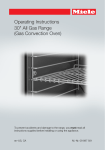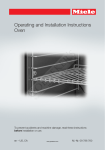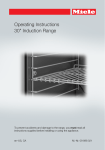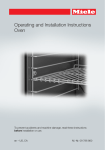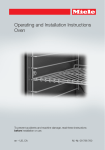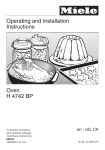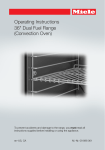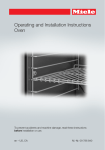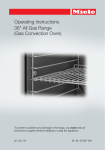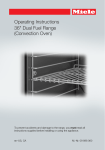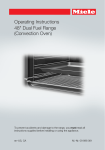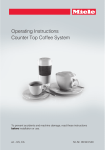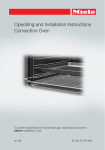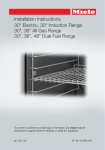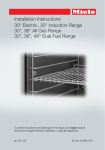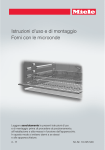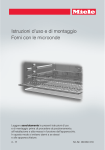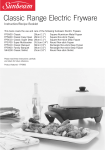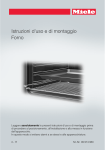Download Miele HR 1421 E Operating Manual
Transcript
Operating Instructions 30" Electric Range To prevent accidents and damage to the range, you must read all instructions supplied before installing or using the appliance. en–US, CA M.-Nr. 09 897 981 IMPORTANT SAFETY INSTRUCTIONS WARNING Children and adults can tip over the range if has not been secured. This may lead to fatal injuries. This range must be secured and connected using the anti-tip device according to the installation instructions. If you have moved the range, slide the locking latch onto the antitip device until you feel it lock into place. Do not use the range if the anti-tip device has not been properly installed and engaged. Failure to observe the information contained in the installation instructions can lead to serious or fatal injuries for children and adults. WARNING All ranges can tip Injury to persons could result Install anti-tip devices packed with range See installation instructions 2 Contents IMPORTANT SAFETY INSTRUCTIONS................................................................. 2 IMPORTANT SAFETY INSTRUCTIONS................................................................. 6 Guide to the range ............................................................................................... 21 Cooktop ................................................................................................................. 21 Oven....................................................................................................................... 22 Control panel ........................................................................................................ 23 Burner control knobs ............................................................................................. 23 Temperature selector ............................................................................................ 24 Operating mode selector ...................................................................................... 24 Clock / Timer.......................................................................................................... 25 Display .............................................................................................................. 25 Symbols in the display...................................................................................... 25 Sensor buttons ................................................................................................. 25 Temperature indicator .................................................................................. 25 Features ................................................................................................................ 26 Model numbers ..................................................................................................... 26 Data plate .............................................................................................................. 26 Items included .................................................................................................. 26 Standard and optional accessories ....................................................................... 26 Shelf runners..................................................................................................... 27 Universal tray and Wire oven rack .................................................................... 27 FlexiClips with wire rack HFCBBR30-2 ............................................................ 28 Cooktop safety features......................................................................................... 32 Overheat protection .......................................................................................... 32 Oven safety features .............................................................................................. 32 System lock for the oven.............................................................................. 32 Cooling fan........................................................................................................ 32 Vented oven door.............................................................................................. 32 Safety Door Lock for Self Clean ....................................................................... 32 PerfectClean treated surfaces ............................................................................... 33 Self Clean ready accessories................................................................................. 33 Before using for the first time............................................................................. 34 Before using for the first time................................................................................. 34 Setting the time of day for the first time ............................................................... 34 Turning on the cooktop for the first time................................................................ 34 Heating the oven.................................................................................................... 34 Operating the cooktop ........................................................................................ 36 How the burners work............................................................................................ 36 3 Contents Cookware............................................................................................................... 36 Energy saving tips ................................................................................................. 37 Burner data ............................................................................................................ 38 Setting range.......................................................................................................... 39 Turning on .............................................................................................................. 40 Turning on the second heating zone................................................................. 40 Turning off .............................................................................................................. 40 Residual heat display........................................................................................ 40 Operating the oven .............................................................................................. 41 Energy saving tips.................................................................................................. 41 Using the oven ....................................................................................................... 41 Cooling fan ............................................................................................................ 41 Preheating the oven .............................................................................................. 42 Guide to the modes.............................................................................................. 43 Clock / Timer ........................................................................................................ 44 Turning a cooking program On / Off automatically ................................................ 44 Setting the cooking time................................................................................... 44 Setting a cooking time and finish time ............................................................. 45 At the end of the cooking time.......................................................................... 46 Changing the cooking time............................................................................... 46 Deleting a cooking time .................................................................................... 47 Deleting a finish time ........................................................................................ 47 Changing the time of day....................................................................................... 48 Changing factory default settings .......................................................................... 49 System lock ....................................................................................................... 52 Timer ...................................................................................................................... 54 Setting the timer ............................................................................................... 54 Bake ...................................................................................................................... 56 Roast ..................................................................................................................... 58 Slow Roasting ...................................................................................................... 60 Broil ....................................................................................................................... 62 Defrost .................................................................................................................. 64 Canning ................................................................................................................. 65 Dehydrate ............................................................................................................. 66 Frozen food........................................................................................................... 67 4 Contents Cleaning and care ................................................................................................ 68 Cooktop: Unsuitable cleaning agents.................................................................... 68 Ceramic surface ..................................................................................................... 69 Oven: Unsuitable cleaning agents ......................................................................... 70 Tips ........................................................................................................................ 70 Normal soiling ........................................................................................................ 71 Stubborn soiling..................................................................................................... 71 Self Cleaning the oven interior ............................................................................... 72 Preparing for the Self Clean program ............................................................... 72 Starting the Self Clean program ....................................................................... 73 At the end of the Self Clean program ............................................................... 74 The Self Clean program is canceled ................................................................. 75 Removing the door ................................................................................................ 76 Reinstalling the door .............................................................................................. 77 Removing the shelf runners ................................................................................... 78 Frequently asked questions ................................................................................ 79 Technical Service ................................................................................................. 83 5 IMPORTANT SAFETY INSTRUCTIONS When using the appliance, follow basic safety precautions, including the following: Read all instructions before installation and use of the range to prevent accidents and machine damage. This range complies with current safety requirements. However, improper use of the appliance can result in personal injury or damage to property. Please read the installation instructions carefully before installing and connecting the appliance. Read the operating instructions before using the range for the first time. To prevent accidents and damage to the appliance, always observe both the installation instructions and operating instructions. Both documents contain important information about installation, safety, use and maintenance. Miele cannot be held liable for damage occurring as a result of non-compliance with the instructions. Keep these installation instructions and operating instructions in a safe place and pass them on to any future owner. 6 IMPORTANT SAFETY INSTRUCTIONS Use This range is intended for domestic use and use in other similar environments. This appliance is not intended for outdoor use. Use the range exclusively under normal domestic conditions: – Use the oven for baking, roasting, broiling, defrosting, canning and drying food. – Use the stovetop to prepare food and keep it warm. Any other use is not permitted. Risk of Fire! Do not use this oven to store or dry combustible materials. Persons who lack physical, sensory or mental abilities, or experience with the appliance should not use it without supervision or instruction by a responsible person. 7 IMPORTANT SAFETY INSTRUCTIONS Children As with any appliance, close supervision is necessary when used by children. Do not leave children unattended: Children should not be alone or unsupervised in the area where the oven is installed. Do not allow them to sit or stand on the appliance. Children must be kept away from the range unless constantly supervised. Children ages eight and up may only use the range without supervision if they have been shown how to use it in a safe manner, and if they are able to recognize and understand the potential risks of improper use. Children must not be allowed to clean or maintain the range without supervision. Please supervise any children in the vicinity of the range and do not let them play with the appliance. Risk of burns! The skin of children is more sensitive to high temperatures than that of adults. – External parts of the oven such as the door glass, vent and control panel become hot. Do not allow children to touch the oven when it is in operation. – The burners of the cooktop will become hot during use. Turn pot and pan handles inward, so children cannot pull them down and be burned. Risk of burns! Danger of burns. Children's skin is more sensitive to high temperatures than that of adults. The oven becomes hotter during self-cleaning than it does in normal use. Do not let children touch the oven while the Self Clean program is running. 8 IMPORTANT SAFETY INSTRUCTIONS Burn hazard from improper use! Do not allow children to operate the oven. Danger of suffocation! Ensure that any plastic wrappings, bags, etc. are disposed of safely and kept out of the reach of children. Burn hazard! Keep the spaces above and behind the range clear of any items that could draw the attention of children. Otherwise, they can be tempted into climbing onto the appliance. Danger of injury. Never allow children to hang or lean on any part of the appliance. 9 IMPORTANT SAFETY INSTRUCTIONS Technical safety Installation, repair and maintenance work should be performed by a Miele authorized service technician in accordance with national and local safety regulations and the provided installation instructions. Contact Miele’s Technical Service Department for examination, repair or adjustment. Repairs and other work by unauthorized persons could be dangerous and may void the warranty. Do not carry or lift the range by the oven door handle or the control panel! Maintenance by the user: Never repair or replace any part of the appliance unless the instructions specifically recommend doing so. Service work may only be performed by a qualified technician. A damaged range can be dangerous. Always check for visible signs of damage. Never use a damaged appliance. Reliable and safe operation of the range can only be guaranteed if it is connected to the public power supply. The electrical safety of the range can only be guaranteed when it is properly grounded. Compliance with this essential safety requirement is absolutely mandatory. If in any doubt, please have the building's wiring system inspected by a qualified electrician. Proper installation: Make sure that your appliance has been installed correctly and that it has been grounded by a qualified technician. To avoid damaging the range, make sure that the connection data (voltage and frequency) on the data plate correspond to the building's power supply before connecting the appliance. When in doubt, consult a qualified electrician. 10 IMPORTANT SAFETY INSTRUCTIONS During installation, maintenance and repair work, e.g. if the oven lighting is broken (see "Frequently asked questions"), the range must be completely disconnected from the household electricity supply. It is only completely isolated from the electricity supply when: – The main circuit breaker has been tripped, or – The plug fuses have been fully unscrewed (where applicable), or – The power cable has been unplugged from the wall outlet. Unplug the cable by pulling on the plug, not on the cord. Do not use a power strip or extension cord to connect the range to electricity. These are a fire hazard and do not guarantee the required level of appliance safety. Any contact with live connections or tampering with the electrical or mechanical components of the range will endanger your safety and may lead to appliance malfunctions. Do not open the appliance housing under any circumstances. This appliance must not be installed and operated in mobile installations (e.g. on a ship). Any repairs not performed by a Miele authorized service technician will void the warranty. Defective components should be replaced by Miele original parts only. Only with these parts can the manufacturer guarantee the safety of the appliance. Risk of electric shock! If the ceramic surface of the stovetop is defective or chipped, cracked or broken in any way, immediately switch the stovetop off and do not continue to use it. Disconnect the range from the power supply and contact Miele Technical Service. If the range is installed behind a cabinet door, do not close the door while the appliance is in operation. Heat and moisture can build up behind the closed door and cause damage to the range and to the surrounding cabinets and flooring. Do not close the door until the appliance has completely cooled down. 11 IMPORTANT SAFETY INSTRUCTIONS Do not install kitchen cabinets above the range, since reaching over a hot stovetop to access the cabinets can result in burns. If it is necessary to install cabinets, you can reduce the risk of burns by installing a range hood that extends at least 4 3/4" (12 cm) past the bottom of the cabinets. 12 IMPORTANT SAFETY INSTRUCTIONS Proper use The oven becomes very hot while in use. Use caution to ensure that you are not burned on the heating elements or interior surfaces of the oven. Use pot holders when placing food in the oven, adjusting the racks, etc. in a hot oven. Caution: Heating elements may be hot even though they are not glowing. Interior surfaces of an oven become hot enough to cause burns. External parts of the oven such as the door glass, vents, and the control panel can become hot. During and after use, do not touch, or let clothing or other flammable materials come into contact with heating elements or interior surfaces of the oven until they have had sufficient time to cool. Do not let food sit in the oven for more than one hour before or after cooking. Doing so can result in food poisoning or sickness. Use only dry, heat-resistant potholders. Moist or damp potholders used on hot surfaces may result in steam burns. Do not let potholders come in contact with oil or grease. Do not substitute dish towels or other bulky items for potholders. Do not let potholders touch hot heating elements. Loose fitting or hanging garments present a fire hazard. Wear proper apparel while operating the appliance. Do not heat up food in closed containers, as pressure will build up in the container, causing them to explode. Do not use the range to boil or heat up cans. Never pour cold water onto hot surfaces in a hot oven. The steam created could cause serious burns or scalding and the sudden change in temperature can damage the enamel in the oven. To prevent burns, always place oven racks at their desired height while the oven is cool. If the rack must be moved while the oven is hot, do not let pot holders touch hot heating elements. 13 IMPORTANT SAFETY INSTRUCTIONS Open the door carefully to allow hot air or steam to escape before placing or removing food. To prevent burns, allow the heating elements to cool before cleaning by hand. Do not leave the oven door open unnecessarily as someone may trip over it or be injured by it. Never leave the appliance unattended when cooking with oil or fat. They can ignite if overheated. Do not use water on grease fires.Turn off the oven immediately and suffocate the flames by keeping the oven door closed. Do not use water on cooktop grease fires. Turn the cooktop off. Smother or use a dry chemical or foam-type extinguisher on any fire or flame. Smother the fire or flames, or use a dry chemical extinguishing agent or foam fire extinguisher. Never store flammable liquids and materials in, above or under an oven, or near cooking surfaces. The high temperatures radiated could cause objects near the oven to catch fire. Do not use the oven to heat the room. WARNING NEVER use this appliance as a space heater to heat or warm the room. Doing so may result in carbon monoxide poisoning and overheating of the oven. WARNING NEVER use this appliance as storage space. Doing so may result in carbon monoxide poisoning and overheating of the oven. 14 IMPORTANT SAFETY INSTRUCTIONS WARNING NEVER cover any slots, holes or passages in the oven bottom or cover an entire rack with materials such as aluminum foil. Doing so blocks air flow through the oven and may cause carbon monoxide poisoning. Aluminum foil linings may also trap heat, causing a fire hazard. Broiling food for an excessively long time can cause it to dry out and may result in the food catching fire. Do not exceed recommended broiling times. Some foods dry out very quickly and can be ignited by high broiling temperatures. Do not use broiling functions for crisping rolls or bread or to dry flowers or herbs. Instead use the Conv Bake (Convection Bake) or Surround functions. Use caution when using alcohol in your recipes. Alcohol evaporates at high temperatures but may, in rare circumstances, combust on the hot heating elements. Plastic or aluminum foil cookware melts at high temperatures and can damage the range or start to burn. Do not use any plastic or aluminum foil cookware. Exception: You can use oven-safe plastic cookware in the oven. Heed the cookware manufacturer's instructions. When residual heat is used to keep food warm, the high level of humidity and condensation can cause damage in the oven. The control panel, countertop or cabinetry may also be damaged. Do not switch the oven off completely while food is inside it, but select the lowest possible temperature for the oven mode you are using. This will ensure the fan will automatically continue to run. It is recommended to cover all cooked food that is left in the oven to be kept warm. This will prevent moisture from condensing on the interior of the oven. 15 IMPORTANT SAFETY INSTRUCTIONS To avoid damage, do not place aluminum foil, pots, pans or baking sheets directly on the oven floor. This can cause a build up of heat that will damage the oven floor. Do not slide pots or pans on the oven floor. This could scratch and damage the surface. The door can support a maximum weight of 33 lbs (15 kg). Do not sit on or lean against an open door, and do not place heavy objects on it. Also make sure that nothing can get trapped between the door and the oven cavity. The oven could get damaged. This oven must only be used for cooking food. Fumes, vapors or heat given off by glues, plastics or flammable liquids and materials could be hazardous. Do not use it as a dryer, kiln, dehumidifier, etc. Do not obstruct the flow of combustion and ventilation air. Do not let metal objects (aluminum foil, pans) come in contact with the heating element. Make certain that the power cords of small appliances do not come in contact with or get caught in the oven door. When baking frozen pizzas or pies, place them on the wire rack lined with parchment paper. Do not use the baking tray or the roasting pan for frozen foods with a large surface area. The tray or pan could become warped and difficult to remove from the oven when hot. Frozen foods like french fries, chicken nuggets, etc. can be baked on the baking tray. The flames could set the grease filters of a ventilation hood on fire. Do not flambé under a ventilation hood. Never heat empty cookware. If the cooktop is covered, there is a risk that the material of the cover will ignite, explode or melt if the range is still hot or if turned on inadvertently. Never cover the cooktop with a board, cloth or protective sheet. 16 IMPORTANT SAFETY INSTRUCTIONS When using an electrical appliance, e.g. a hand mixer, near the cooktop, make sure that the power cable does not come into contact with the hot cooktop. The cable's insulation could become damaged. The cooktop gets hot when in use and remains hot for a while after being turned off. There is a potential hazard until the residual heat indicator goes out. If the cooktop is turned on or accidentally turned on or if it is still hot, metal objects on the cooktop can heat up. Other items may melt or catch fire. Damp lids can become attached to the cooktop by suction. Do not store items on the cooktop! Always turn the burners off after use! Do not allow solid or liquid sugar, or pieces of plastic or aluminum foil to get onto the burners when they are hot, as they can damage the ceramic surface when it cools down. If this should occur, turn off the appliance and scrape off all the sugar, plastic or aluminum residues while still hot, using a shielded scraper blade. Wear oven gloves. Allow the burners to cool down and clean them with a suitable ceramic cleaning agent. Pans that boil dry can cause damage to the ceramic glass. Do not leave the appliance unattended while it is being used. Pots and pans with bases with pronounced edges or ridges can scratch the ceramic burner. Only use pots and pans with smooth bases. Lift pans into position on the cooktop. Sliding them into place can cause scuffs and scratches. Grains of salt, sugar and sand (e.g. from cleaning vegetables) can cause scratches if they get under pan bases. Make sure that the ceramic surface is clean before placing pans on it. Even a light object can cause damage to the ceramic cooktop in certain circumstances. Do not drop anything on the ceramic surface. 17 IMPORTANT SAFETY INSTRUCTIONS Hot pans on the display can cause damage to the electronics underneath. Do not place hot pans on the area around the display. The cooktop frames or surrounding (in the case of beveled cooktops) may become hot due to the following factors: operating time, high output settings, large cookware, and number of burners in operation. Cookware of aluminum or with an aluminum base can cause shiny metallic spots. These spots can be removed with ceramic glass or stainless steel cleaner (see "Cleaning and Care"). If residue remains on the cooktop for any length of time, it can cook into the cooktop and sometimes it is then not possible to remove it. Remove spills and splatters promptly. Also make sure that the bottom of any cookware is clean, dry, and free of grease before placing it on the cooktop. The cooktop has burners of different sizes. Use cookware with a level base that is large enough for the burner. Cookware that is too small leaves part of the hot burner uncovered, which may cause burns due to touching or ignite clothing. The use of cookware of the right size also makes for better use of the heated areas. Not any cookware of glass, glass ceramic, ceramic, clay or other glass cookware is suitable for use on a burner. It can be damaged due to sudden temperature change. Wet sponges or clothes can cause burns due to hot steam if they are used to wipe spilled food off a hot burner. Some cleansers can emit hazardous vapors if they are applied to a hot surface. Be careful when cleaning the cooktop. Spilled food can cause odors and the spraying of grease, which can ignite on the cooktop. Never leave the cooktop unsupervised at high power. 18 IMPORTANT SAFETY INSTRUCTIONS If the handles of a pot or pan extend across an adjacent burner, this can cause burns, the ignition of flammable materials and the spilling of food due to inadvertent contact with the cookware. Turn the pot or pan so that the handles point toward the inside and do not extend across an adjacent burner. If the burner is damaged, cleansers or spilled food can penetrate the glass surface and cause a short-circuit. Never cook on a damaged burner. Contact an electrician immediately. Cleaning and care Do not use a steam cleaner to clean the range. The steam may reach electrical components and cause a short circuit. Only clean parts listed in these Operating and Installation Instructions. Scratches on the door glass can cause the glass to break. Do not use abrasive cleaners, hard sponges, brushes or sharp metal tools to clean the door glass. The shelf runners can be removed for cleaning purposes (see "Cleaning and care"). Ensure they are correctly fitted after cleaning and never operate the oven without the shelf runners inserted. There is a seal around the oven interior which seals the inside of the door. Take care not to rub, damage or move the gasket. Do not use oven cleaners. Commercial oven cleaners or oven liners of any kind should not be used in or around any part of the oven. Debris should be removed before running the Self Clean program. If not removed this debris can smoke causing the self-cleaning program to turn itself off. 19 IMPORTANT SAFETY INSTRUCTIONS Accessories Use only genuine original Miele parts. If parts or accessories from other manufacturers are used, the warranty will become void. The high temperatures used during self-cleaning will damage accessories that are not designed for cleaning in the Self Clean program. Please remove these accessories from the oven before starting the Self Clean program. This also applies to accessories purchased separately (see "Cleaning and care"). SAVE THESE INSTRUCTIONS AND REVIEW THEM PERIODICALLY 20 Guide to the range Cooktop a Variable burner 8 1/4" - 10 5/8" (21 cm - 27 cm) d Variable burner 4 3/4" - 7" (12 cm - 18 cm) b Standard burner 5 11/16" (14.5 cm) e Residual heat indicator c Variable burner 5 11/16" - 8 1/4" (14.5 cm - 21 cm) 21 Guide to the range Oven a Oven and cooktop controls e TwinPower convection fan with heating element b Door lock with contact switch for Self f Shelf runners with 6 levels Clean * c Browning / Broiling element d Oven interior lighting g Data plate The data plate is located behind the toe-kick. h Door * This switch ensures that the heating elements and the convection fans turn off when the door is opened during use. 22 Control panel a Burner knobs b Temperature selector c Optical interface (for Service technicians only) d Timer with display and sensor buttons for light, , OK, , and the time. e Operating mode selector Burner control knobs The range is equipped with various cooking zone functions: Symbol 0 1–12 Description Burner off Power levels Turning on a variable burner 23 Control panel Temperature selector Operating mode selector The temperature selector is used to select the temperature for a cooking mode. To select an operating mode. It can be turned clockwise until a resistance is felt and then turned back again. The temperature settings are marked on the temperature selector. It can be turned clockwise or counterclockwise. The operating modes are printed on the mode selector. Operating modes – Rapid (Rapid PreHeat) – Bake – Broil – Surround – Clean (Self Clean) – Conv Broil (Convection Broil) – Conv Bake (Convection Bake) 24 Control panel Clock / Timer Sensor buttons The clock/timer is operated via the Display with the sensor buttons. The range has sensor buttons for light, , OK, , and timer, which react to the touch of a finger. Each touch is confirmed with an audible tone. Display h min Light The tone can be turned on or off by selecting the status in the settings (see "Settings"). Temperature indicator OK Timer The display shows the time of day or your settings. – and the temperature indicator light goes out. Symbols in the display Depending on the position of the mode selector and/or which button is pressed, the following symbols will appear: Timer When the set temperature is reached, – the oven heating turns off, See "Clock / Timer" for more information. Symbol / Mode The temperature indicator light lights up when the oven is heating. The temperature regulator ensures that the oven heating and temperature indicator light turn back on again when the oven temperature falls below the level set. Any Temperature indicator Cooking time Finish time Operating mode Settings Off Time of day System lock A mode can only be set or changed if the mode selector is in the correct position. 25 Features Model numbers A list of the ovens described in these operating instructions can be found on the back page. Standard and optional accessories The data plate is behind the toe-kick. The toe-kick cover is attached to the base of the range by magnets so it can be removed and put back again easily. Accessories vary depending on model. All ovens are supplied with shelf runners, a universal tray and a wire rack. Depending on the model, your range may also be supplied with other accessories listed here. There you can find the model number, the serial number and the connection data (voltage/frequency/maximum rated load) for your range. All accessories and cleaning and care products listed in these instructions are designed to be used with the Miele range. Have this information available when contacting Miele Technical Service. These can be ordered via the Miele website, from Miele (see end of this booklet for contact details) or from your Miele dealer. Data plate Items included The range is supplied with: – installation instructions, – operating instructions, – an anti-tip device including screws for fastening the range, – various accessories. 26 When ordering, please have ready the model number of your range and of the desired accessories. Features Shelf runners Universal tray and Wire oven rack The shelf runners are located on the right and left-hand sides of the oven with the levels for inserting accessories. Universal tray HUBB30-1 The shelf level numbers are indicated on the front of the oven frame. Wire oven rack HBBR30-2 Each level consists of a strut on which you can place the wire oven rack, for example. The runners can be removed for cleaning purposes. See "Cleaning and Care". Non-tip safety notches are located on the shorter sides of these accessories.These prevent the trays being pulled completely out of the side runners when you only wish to pull them out partially. Always place the wire oven rack on the runner with the notch facing down. When using the universal tray, place it directly on the wire oven rack. 27 Features FlexiClips with wire rack HFCBBR30-2 If the FlexiClips with wire rack jams when sliding it onto the level, pull it out using some force and reinsert. To removing the FlexiClips with wire rack: Push the FlexiClips with wire rack in all the way. The FlexiClips with wire rack can be mounted on any shelf level and pulled completely out of the oven This allows you to see the food easily. The FlexiClips with wire rack is pushed in and then locked onto a level. The rack can hold a maximum of 33 lbs (15 kg). Installing and removing the FlexiClips with wire rack Danger of burns! Make sure the heating elements are turned off and that the oven cavity is cool. Do not pull the FlexiClips apart during installation or removal. Hold the FlexiClips with wire rack with both hands and position it in front of the desired level. Insert the FlexiClips with wire rack onto the level (1.) and slide it along the struts of the level (2.) until it clicks into place. 28 Using both hands lift the front of the FlexiClips with wire rack on both sides (1.) and pull it out of the level (2.). Using the universal tray When using the universal tray, place it directly on the FlexiClips with wire rack. Features Temperature selector with °C scale The range is delivered with a temperature selector with °F scale. You can get the temperature selector with °C scale as an accessory. Specify the model of your range when purchasing. Replacing the temperature selector Do not operate the range without an installed temperature selector. Turn the temperature selector to (Off). Pull the temperature selector off the range horizontally. Install the new temperature sensor in the same position and push it onto the range. Perforated baking tray HBBL71 The perforated baking tray has been specially developed for the preparation of baked goods. The tiny perforations assist in browning the underside of baked goods. The tray can also be used for dehydrating or drying food. The surface has been treated with PerfectClean enamel for easy cleaning. The perforated baking tray can be placed on the rack. Grilling and Roasting insert HGBB30-1 The grilling and roasting insert is placed in the universal tray. The drippings from the meat or poultry are collected under the insert reducing spattering in the oven. The drippings can then be used for gravy and sauces. The surface has been treated with PerfectClean enamel for easy cleaning. 29 Features Round baking form HBF27-1 This circular form is suitable for cooking fresh or frozen pizzas, flat cakes, tarts and baked goods. The surface has been treated with PerfectClean enamel. Gourmet Baking Stone HBS60 The baking stone is ideal for baking dishes with a crisp bottom such as pizza and bread. The baking stone is made from a heat retaining stone and is glazed. Place the stone directly on the wire rack. A wooden peel is supplied with it for placing food on and off the stone. 30 Gourmet Casserole Dishes HUB and Lids HBD Miele Gourmet Casserole Dishes can be placed directly on the wire oven rack. They have an anti-stick coating. The oven dishes have depths of 8 1/2" (22 cm) or 13 3/4" (35 cm). They have the same width and height. Matching lids are also available separately. Depth: 8 1/2" (22 cm) Depth: 13 3/4" (35 cm) HUB61-22 HUB61-35 HBD60-22 HBD60-35 Features Opener The opener allows you to open the cover of the over light. Miele Oven Cleaner Miele oven cleaner is suitable for removing stubborn soiling. It is not necessary to preheat the oven before use. Ceramic and stainless steel cleaner 250 mL Removes heavy soiling, lime scale, and aluminum residue. 31 Features Cooktop safety features Overheat protection Each burner has overheat protection (inner temperature limiter). It turns the heating of the cooking off automatically before it overheats. As soon as the burner has cooled off, the heating turns on again. Overheating can be caused by: – turning a burner on without putting a pan on it, – heating empty cookware, – a pan with an uneven bottom not sitting evenly on the burner, – the pan not conducting heat properly. You will recognize activation of the overheat protection if the heat keeps turning on and off at the highest power setting. Oven safety features System lock for the oven The system lock prevents the oven from being used unintentionally (see "System lock "). The system lock will remain activated even after a power failure. Cooling fan The cooling fan comes on automatically when a cooking program is started. The cooling fan mixes hot air from the oven cavity with cool room air before venting it out into the kitchen through vents located between the appliance door and the control panel. 32 The cooling fan will continue to run for a while after a program is complete to prevent moisture from building up in the oven, on the control panel or surrounding cabinetry. When the temperature in the oven has fallen sufficiently, the cooling fan will turn off automatically. Vented oven door The oven door is made of glass panes that have a heat-reflective coating on part of their surface. During operation, air is also circulated through the door to keep the outer panel cool. The door can be removed and disassembled for cleaning purposes (see "Cleaning and care"). Safety Door Lock for Self Clean For safety reasons, the door is locked as soon as the Self Clean program is started. After the self-cleaning program has finished, the door will remain locked until the temperature in the oven has fallen below 535°F (280°C). Features PerfectClean treated surfaces The revolutionary PerfectClean enamel is a smooth, non-stick surface that cleans easily with a sponge. Food and soiling from baking and roasting can be easily removed from these surfaces. Do not use ceramic knives as these will scratch the PerfectClean surface. Follow the instructions in the "Cleaning and Care" section of this manual so the anti-stick and easy cleaning properties are retained. The following have all been treated with PerfectClean: – Universal tray – Grilling and Roasting insert – Perforated baking tray – Round baking form Self Clean ready accessories The following accessories can be left in the oven during the Self Clean program. – Shelf runners, – FlexiClips with wire rack – Wire oven rack See "Cleaning and care" for more information. 33 Before using for the first time Before using for the first time The range may only be operated after it has been installed properly. Read the operating and installation instructions carefully before installing the range.. Read the operating instructions carefully before starting up the range. The time of day can only be changed when the mode selector is set to Off. Set the time of day. Setting the time of day for the first time The time of day is shown in 12 hour clock format. After connection the oven to the electrical supply will appear in the display and a will flash under : Use or to set the time of day. Confirm with OK. The time of day is now saved. Change the time of day to a 12-hour format by setting h in the settings menu (see "Settings"). During a power failure, the time of day will be saved for approx. 200 hours. If the power returns within this period of time the current time of day is displayed again. If the power is out for an extended period of time the time of day will need to be reset. The time is day is turned off by default (see "Settings - "). The display will appear dark when the oven is turned off. The time of day continues to run unseen in the background. Turning on the cooktop for the first time Remove any protective foil and stickers. Before first use, wipe down the appliance with a damp cloth and dry it. Metal components are protected by a conditioning agent. Smells and vapor may occur when the appliance is used for the first time. The smell and any vapors do not indicate a faulty connection or a defective appliance and are not harmful to your health. Heating the oven New ovens may have a slight odor during their first use. Heating up the oven for at least an hour with nothing in it will eliminate the odor. 34 Before using for the first time Ensure that the kitchen is well ventilated while the appliance is being heated up for the first time. Close doors to other rooms to prevent the smell spreading throughout the house. Remove any protective wrapping and sticky labels from the oven. Clean the oven interior with warm water and liquid dish soap, applied with a soft sponge or cloth. Dry all surfaces with a soft cloth. Turn the oven lighting off. Leave the oven door open until the oven interior is completely dry. Take all accessories out of the oven and clean them (see "Cleaning and care"). Before heating the oven up, wipe the interior with a damp cloth to remove any dust or bits of packaging that may have accumulated in the oven cavity during storage and unpacking. Select the operating mode Conv Bake (Convection Bake) The oven heating, lighting and cooling fan will turn on. Select the maximum temperature 475°F (250°C). Heat up the oven for at least one hour. Once the heating up process is complete, turn the mode selector to Off and the temperature selector to (Off). After heating up for the first time Danger of burns! Allow the oven to cool before cleaning. Select "Light" to turn on the oven light. 35 Operating the cooktop How the burners work Each burner has overheat protection, which prevents the overheating of the ceramic top (see "Overheat protection"). Standard burners have one heating band, variable burners have two heating bands. If a power level is set, the heating turns on and the heating band is visible through the ceramic top. The heat output of the burners depends on the power level set and is controlled electronically. This causes the "cycling" of a burner: the heating is turned on and off. Cookware The most suitable cookware is metal pots and pans with thick bottoms that, when cold, bulge inwards slightly. On warming, the bottom extends and sits level on the burner; this conducts the heat optimally. cold hot Glass, ceramic or stoneware is less suitable. These materials do not conduct the heat well. Not suitable are plastic and aluminum dishes. These melt at high temperatures. 36 Cookware of aluminum or with an aluminum base can cause shiny metallic spots. These spots can be removed with ceramic glass or stainless steel cleaner (see "Cleaning and Care"). Pots and pans with bases with pronounced edges or ridges can scratch the ceramic burner. Only use pots and pans with smooth bases. Lift pans into position on the cooktop. Sliding them into place can cause scuffs and scratches. Often the maximum diameter quoted by manufacturers refers to the diameter of the top rim of the pot or pan. The diameter of the base (generally smaller) is more important. Operating the cooktop Energy saving tips – Ensure that the bottoms of pots or pans match the size of the burner or are somewhat larger. This ensures that heat is not lost unnecessarily. – Use a lid whenever possible to minimize heat loss. – For small quantities, select a small pan. A small pan on a small burner uses less energy than a large, only partially filled pan on a large burner. – Cook with as little water as possible. – Once food has come to the boil or the pan is hot for frying, reduce the heat to a lower power setting. – When cooking for a long time, turn the burner off at least 5 or 10 minutes before the end of the cooking time. This makes use of the residual heat. 37 Operating the cooktop Burner data Burner Output in Watts at 208 V and 60 Hz Output in Watts at 240 V and 60 Hz left front (variable burner) 8 1/4" / 10 5/8" (21 cm / 27 cm) 2000 / 2800 2300 / 3100 left rear (standard burner) 5 11/16" (14.5 cm) 1200 1200 right rear (variable burner) 5 11/16" / 8 1/4" (14.5 cm / 21 cm) 700 / 1800 700 / 1800 right front (variable burner) 4 3/4" / 7" (12 cm / 18 cm) 1100 / 2400 1100 / 2400 Total: 8200 Total: 8500 38 Operating the cooktop Setting range Melting butter, chocolate, etc. Dissolving gelatin Thickening sauces containing only egg yolk and butter Warming small quantities of liquid Keeping food warm that sticks easily Cooking rice Warming liquid and semi-solid foods Thickening creams and sauces. Preparing omelets, lightly fried eggs Steaming fruit Thawing frozen foods Steaming vegetables, fish Cooking pasta, legumes Swelling grains Bringing to a boil and continued cooking of large quantities of food Gentle braising (without overheating the fat) of fish, cutlets, sausages, fried eggs, etc. Frying pancakes, etc. Boiling large quantities of water Bringing to a boil Setting range 1-2 1-3 3–5 4–6 7 8–9 9–11 11–12 These settings, which refer to approx. 4 servings, should only be taken as a guide. With deep pans, larger quantities or when cooking without a lid, a higher setting is required. For smaller quantities, select a lower setting. 39 Operating the cooktop Never heat an empty pot! This Residual heat display can damage the glass ceramic surface. Never leave the cooktop unattended during use! When after turning on one burner, for example the left front, a specified temperature is reached, the associated residual heat indicator lights up: Hot pans on the display can A little while after turning off the burner, the residual heat indicator goes out. cause damage to the electronics underneath. NEVER place hot pots or pans near the display. The burner control knobs have a stop. Never turn the knob to the right to 0, past the symbol or the last number. Turning on Press the burner knob and turn it to the right to the desired setting. Turning on the second heating zone Variable burners have a second heating zone that you can turn on. You have to overcome slight resistance in order to turn the knob from 12 to . Press the burner knob in and turn it clockwise past "12" to the stop, to . The second heating zone turns on. Then turn the knob to the left to the desired setting. Turning off Turn the burner knob to the left to 0. 40 Risk of burns! Do not touch the burners while the residual heat indicators are on. Operating the oven Energy saving tips Using the oven – Remove any accessories from the oven that you do not require for cooking. Place the food in the oven. – Only preheat the oven if the recipe or cooking chart advises. – Try not to open the door when cooking. – If a temperature range is given, it is best to select the lower temperature and check the food after the shortest cooking time given. – Use the operating mode Conv Bake (Convection Bake). You can use cooking temperatures 10-30° lower than when using other modes. – Conv Broil (Convection Broil) can be used for a wide variety of foods. Lower temperatures can be used than with other broil modes that use the maximum temperature setting. Using residual heat Tip: When cooking using temperatures above 285°F (140°C) and cooking durations longer than 30 minutes, you can turn the temperature selector to the (Off) position about 5 minutes before the end of cooking. The heating elements will turn off and the residual heat in the oven will be sufficient to finish cooking the food. Using the mode selector, select the required oven mode. The oven lighting and the TwinPower fans will turn on. Select the temperature using the temperature selector. The oven heating will turn on. After the cooking process: Turn the mode selector to Off and the temperature selector to (Off). Take the food out of the oven. Cooling fan After the cooking process the cooling fan will continue to run for a while after a program is complete to prevent moisture from building up in the oven, on the control panel or surrounding cabinetry. When the temperature in the oven has fallen sufficiently the cooling fan will turn off automatically. 41 Operating the oven Preheating the oven Rapid PreHeat The appliance only needs to be preheated in a few cases. With Rapid (Rapid PreHeat) the preheating phase can be shortened. Most dishes can be placed in a cold oven. They will then use the heat produced during the heating phase. The oven should be preheated in the following instances: Do not use Rapid (Rapid PreHeat) when baking pizzas or delicate mixtures (e.g. small cakes, pastries). The tops of these items will brown too quickly. Conv Bake (Convection Bake) Select Rapid (Rapid PreHeat). – dark bread doughs, Select a temperature. – beef sirloins and tenderloins. Set the desired oven function when the temperature indicator light goes out for the first time. Surround – cakes and pastries with a short baking time (up to 30 minutes), – delicate mixtures, – dark bread doughs, – beef sirloins and tenderloins. 42 Place the food in the oven. Guide to the modes The oven has a range of modes for preparing a variety of foods. Rapid (Rapid PreHeat) (Browning / Broiling element + Convection fan with heating element) This function allows the oven to be heated to the desired temperature quickly. Once the desired temperature has been reached the oven function must be selected. Conv Broil (Convection Broil) (Browning / Broiling element + Convection fans) This allows for a lower temperature to be used then when using broil. Ideal for broiling thicker cuts of meat (e.g. roulades, chicken). This function distributes hot air from the browning / broiling element over the food using the fan. Conv Bake (Convection Bake) Bake (Convection fans with heating element) (Baking element) Use this mode for baking and roasting on several levels at the same time. You can cook at lower temperatures than with the Surround function because the fans distribute the heat evenly throughout the cavity for a consistent baking temperature. This mode uses traditional baking techniques to perfect pies and biscuits. Broil (Browning / Broiling element) Use this function for broiling or searing small quantities. Ideal for chops, ribs, browning baked dishes and toasting bread. Surround (Browning / Broiling element + Baking element) This premium baking mode uses heat from the upper and lower elements to create perfect results on all baking recipes. If using an older recipe or cookbook, set the oven temperature 10 ° lower than that recommended. This won't change cooking times. 43 Clock / Timer Turning a cooking program On / Off automatically You can set a cooking program to turn on or off automatically. First the mode and cooking temperature must be selected. The maximum duration that can be set for a cooking program is 12 hours. It It is recommended to use the automatic On/Off feature when roasting. Do not delay the start of the program for too long when baking. Cake mixtures and doughs will dry out, and the leavening agents will lose their effectiveness. Setting the cooking time Example: Baking a cake for 1 hour 5 minutes. Place the food in the oven. Select the required oven mode and temperature. The oven heating, lighting and cooling fan will turn on. Select OK. If necessary, move the symbol with or until it appears under . Confirm with OK. h will appear in the display along with a flashing under . h Use or to set the cooking time (). Confirm with OK. The cooking time is saved and then counts down in minutes, with the last minute counting down in seconds. The symbol indicates that a cooking time has been set. 44 Clock / Timer Setting a cooking time and finish time Example: The time is now 11:15 AM; you want a dish with a cooking time of 90 minutes to be ready by 1:30 PM. Place the food in the oven. Set the finish time: Move the symbol with or until it appears under . appears: Select the required oven mode and temperature. The oven heating, lighting and cooling fan will turn on. Confirm with OK. Set the cooking time: will appear in the display (current time of day + cooking time = + ): Select OK. If necessary, move the symbol with or until it appears under . Confirm with OK. h will appear in the display along with a flashing under . Use or to set the cooking time (). Use or to set the end of the cooking time (). Confirm with OK. The finish time is now saved: Confirm with OK. The cooking time is saved and then counts down in minutes: h The oven heating, lighting and cooling fan will turn off. As soon as the start time ( - = ) has been reached, the oven heating, lighting and cooling fan will turn on. 45 Clock / Timer At the end of the cooking time Changing the cooking time – appears in the display, Select OK. – flashes, If necessary, move the symbol with or until it appears under . – the oven heating and lighting will turn off, – the cooling fan will continue to run, and The cooking time remaining appears in the display. Confirm with OK. – a signal will sound if turned on (see "Settings - "). Change the cooking time with or . Turn the mode selector to Off. Confirm with OK. Take the food out of the oven. The changed cooking time is now saved. If the dish is not cooked to your liking, you can extend the cooking time by entering a new time. 46 Clock / Timer Deleting a cooking time Deleting a finish time Select OK. Select OK. If necessary, move the symbol with or until it appears under . If necessary, move the symbol with or until it appears under . Confirm with OK. Confirm with OK. The symbol will flash under . The symbol will flash under . Use to set the cooking time to . Use or to set the end of the cooking time to . Confirm with OK. Confirm with OK. The cooking time and finish time are deleted. The finish time is now deleted. Select OK. The current temperature will appear. The oven heating remains turned on. If you would like to complete the cooking program: Turn the mode selector to Off. Take the food out of the oven. Turn the oven off. If you turn the mode selector to 0, the settings for the cooking time and the finish time will be deleted. 47 Clock / Timer Changing the time of day The time of day can only be changed when the mode selector is set to Off. Turn the mode selector to Off. Select OK. Move the symbol with or until it appears under . Confirm with OK. The symbol will flash under . Use or to set the time of day. Confirm with OK. The time of day is now saved. During a power failure, the time of day will be saved for approx. 200 hours. When the power returns within this period of time the current time is displayed again. After an extended power failure, the time of day will need to be reset. 48 Clock / Timer Changing factory default settings The appliance is supplied with a number of default settings (see the "Settings overview" chart). A setting can be changed by altering its status. The settings can only be changed when the mode selector is on Off. Select OK. If necessary, move the symbol with or until it appears under . The setting is selected and the current status appears, e.g. . To change the status: Set the desired status using or . Confirm with OK. The status is saved and the setting appears again. If you would like to change additional settings, repeat the process. If you have completed changing settings, select . The settings will remain in memory even in the event of a power failure. Confirm with OK. appears: If you want to change another setting, select the appropriate number with or . Confirm with OK. 49 Clock / Timer Settings overview Setting Status Time of day display * The time of day display is turned off. The display is dark when the oven is turned off. The time of day continues to run unseen in the background. If you have selected status , the oven must be turned on before it can be used. This also applies for the Timer and Light. The oven also switches off automatically if no settings are selected within a certain period of time (approx. 30 minutes). The time of day display is turned on and is visible in the display. Buzzer volume The buzzer is Off. to * The buzzer is On. The volume can be changed. The corresponding buzzer will be heard when a status is selected. Keypad tone The keypad tone is turned off. * The keypad tone is turned on. Clock format The time of day is shown in a 24-hour format. * The time of day is shown in the 12-hour format. If you change the clock after 1 pm (13:00) from a 12hour clock to a 24-hour clock, you will need to update the hours for the time of day accordingly. 50 Clock / Timer Setting Status Display brightness to , * Lighting * The oven interior lighting is on for 15 seconds and then turns off automatically. The oven interior lighting is permanently turned on. Different levels of brightness can be selected for the display. : Minimum brightness : Maximum brightness Temperature regulation The temperature can be modified so that it is slightly to higher or lower than shown. Demo Mode * Select and press OK for approx. 4 seconds. When appears in the display the demo mode is deactivated. Select and press OK for approx. 4 seconds. When appears in the display the demo mode is active. The higher the level, the higher the cooking temperature. The oven can be operated, but the oven heating does not work. For personal use you do not need this setting. * Factory default 51 Clock / Timer System lock To activate the system lock The system lock prevents the oven from being used unintentionally. Select OK. The system lock is set of off by default. This can be changed by setting the status : – = Off – = On The status of the system lock can only be changed when the mode selector is in the Off position. Move the symbol with or until it appears under . Confirm with OK. The currently set status appears and the symbol flashes under : Use or to set the status . Confirm with OK. The system lock is turned on. When the appliance is turned on again, the symbol will appear in the display to remind you that the system lock has been activated. The system lock will remain activated even after a power failure. 52 Clock / Timer Deactivating the system lock for a cooking process Select an operating mode. The and symbols will appear along with the current time of day: Press and hold OK until goes out. The oven can now be used. Deactivating the system lock Turn the mode selector to Off. Press and hold OK until goes out. Select OK. Move the symbol with or until it appears under . Confirm with OK. The currently set status appears and the symbol flashes under . Use or to select the status . Confirm with OK. The system lock is Off. The symbol disappears. 53 Clock / Timer Timer Setting the timer The timer can be used to time any activity in the kitchen , e.g. boiling eggs. Example: Boiling eggs and setting the timer for 6 minutes and 20 seconds. The timer can also be used at the same time as a cooking program if a start and finish time have been set, e.g. a reminder to stir the dish or add seasoning. will appear in the display with flashing under : A maximum time of 99 minutes and 55 seconds can be set for the timer. Select Timer. min Use or to set the timer as desired. min Confirm with OK. The timer settings are saved and will count down in seconds: min The symbol indicates that the timer has been set. 54 Clock / Timer At the end of the timer Resetting the timer – flashes, Select Timer. – the time starts counting upwards, The current timer appears. – a signal will sound if turned on (see "Settings - "). Change the time set with or . Select Timer. The signal will turn off and the symbols in the display will go out. Confirm with OK. The changed time is saved and will count down in seconds. Canceling the timer Select Timer. Use to reduce the timer to . Confirm with OK. The timer has been canceled. 55 Bake Eating food which has been cooked correctly is important for good health. Only bake cakes, pizza, french fries, etc. until they are golden brown. Do not overcook them. Operating modes Depending on how you would like the food prepared, you can use Conv Bake (Convection Bake) or Surround. Bakeware The bakeware used depends on the oven mode chosen and how the food is prepared. – Conv Bake (Convection Bake): Baking tray, Universal tray, any heatresistant baking dishes – Surround: Dark metal, enamel or aluminum baking tins with a matte finish, as well as heat-resistant glass, ceramic and coated dishes can be used. Avoid bright, shiny metal tins as they result in uneven or poor browning, and in some cases cakes might not cook properly. 56 – Always place baking pans on the wire rack. Position rectangular pans with the longer side across the width of the rack. This will allow for optimum heat distribution and even baking results. – When baking cakes with fruit toppings or deep cakes, place the pan in the universal tray to catch any spillages. Parchment paper / Greasing the pan All Miele accessories (baking tray, universal tray and round baking form) are treated with PerfectClean enamel. Surfaces treated with PerfectClean enamel generally do not need to be greased or covered with parchment paper. Parchment paper is only needed with: – anything with a high salt content (e.g. pretzels, bread sticks), because sodium can damage the PerfectClean surface; – meringues or dishes with a high eggwhite content, because they are more likely to stick, – frozen food cooked on the wire rack. Bake Temperature Shelf levels As a general rule, select the lower temperature given in the chart. The shelf level that you place the food on for baking depends on the oven mode and the number of trays being used. Choosing a baking temperature higher than those recommended may reduce the cooking time, but will lead to uneven browning, and unsatisfactory cooking results. Baking duration Check if the food is cooked at the end of the shortest duration quoted. To check if a cake is ready insert a wooden skewer or toothpick into the center, it should come out clean. – Conv Bake (Convection Bake) 1 Tray: level 3 2 Trays: levels 1+3 / 2+4 3 Trays: levels 1+3+5 – Surround 1 Tray: Level 3 Bake moist cakes and muffins on a maximum of two levels at the same time. 57 Roast Always follow USDA guidelines on food safety. Operating modes Depending on how you would like the food prepared, you can use Conv Bake (Convection Bake) or Surround. Cookware Any heat-resistant cookware can be used: Wire oven rack, grilling and roasting insert (if available) on top of the universal tray, roasting pans, heatresistant glass/earthen/cast iron cooking and roasting bags. Temperature As a general rule, select the lower temperature given in the chart. If higher temperatures are used, the meat will brown on the outside, but will not be properly cooked through. When cooking with Conv Bake (Convection Bake), select a temperature 25°F (20°C) lower than when using Surround. Select a temperature of approx. 25°F (10°C) lower than quoted in the roasting chart for meat weighing more than 6.5 lbs (3 kg).The roasting process will take longer, but the meat will cook evenly through and the skin or crackling will not be too thick. When roasting on the rack, set a temperature approx. 10° lower than if using an oven dish. 58 Shelf levels In most cases level 3 should be used. With large items, such as a turkey, use level 1 or 2. Roast Tips – Resting time: At the end of the program, take the roast out of the oven, cover with aluminum foil and let stand for about 10 minutes. This helps retain the juices when the meat is sliced. – The larger the cut of meat to be roasted, the lower the temperature should be. The roasting process will take a little longer, but the meat will be cooked evenly and the outside will become crisp. – Use a roast probe for accurate cooking temperatures and best results. 59 Slow Roasting This cooking method is ideal for cooking beef, pork, veal or lamb when a tender result is desired. First, using a cooktop sear the meat on all sides to seal in the juices. Then place the meat in a preheated oven. It will be cooked at a low temperature for an extended time allowing the meat to become very tender. The meat will rest and the juices start to circulate evenly throughout. This gives the meat a very tender and juicy result. Operation Use the universal tray with the grilling and roasting insert. Place the rack with the universal tray on shelf level 3. Select Surround and a temperature of 265°F (130°C). Preheat the oven along with the universal tray and wire rack for approx. 15 minutes. While the oven is preheating, sear the meat on all sides on the cooktop. Tips Danger of burns! – Use fresh, lean meat that has been trimmed. Remove the bones before cooking. When the oven is hot use pot holders to insert, remove or turn the food, or when adjusting the oven shelves, etc. – When searing, use a suitable cooking oil or fat that can withstand high temperatures (e.g. clarified butter, vegetable oil). – Do not cover the meat during cooking. Cooking will take approx. 2-4 hours, depending on the size and weight of the meat, as well as the desired degree of doneness and browning. 60 Place the seared meat on the universal tray. Reduce the temperature to 210°F (100°C). Continue cooking until the end of the cooking time. On models with a clock/timer, you can set the cooking process to finish automatically (see "Clock/Timer Setting the cooking duration"). Slow Roasting After the cooking process Because the cooking temperatures are very low: Cooking time / Core temperatures Always follow USDA guidelines on food safety. – the meat can be carved immediately, it does not need to rest. Meat Time [min] Core Temp. [°F / °C] ** 80–100 138 / 59 50–70 118 / 48 – medium 100–130 135 / 57 – well done 160–190 156 / 69 Pork tenderloin 80–100 145 / 63 Smoked pork chop * 140–170 154 / 68 Veal fillet 80–100 140 / 60 Veal loin * 100–130 145 / 63 50–80 140 / 60 – the cooking result will not be affected if the meat is left in the oven after the program is complete. It can be kept warm until you serve it. – the meat is at an ideal temperature to eat right away. Serve on heated plates with a hot sauce or gravy to keep it warm. Fillet of beef Roast beef – rare Saddle of lamb * * boneless ** If desired, use a roast probe to monitor the core temperature. 61 Broil Danger of burns! Broil with the oven door closed. If you broil with the door open the hot air will escape from the oven before it has been cooled by the cooling fan. The controls will get hot. Oven modes Broil For broiling thin cuts of meat and browning. Temperature As a general rule, select the lower temperature given in the chart. If higher temperatures are used, the meat will brown on the outside, but will not be properly cooked through. Preheating Always preheat the oven for about 5 minutes with the door closed before Broiling. Shelf levels The entire Browning / Broiling element will get hot and glow red. Select the shelf level according to the thickness of the food. Conv Broil (Convection Broil) – Thin cuts: Shelf level 4 or 5 For broiling thicker items, e.g. roulades, poultry pieces. – Thick cuts: Shelf level 2 or 3 The Browning / Broiling element and the fan turn on alternately. Cooking accessories Broiling duration Thick pieces of fish and meat take approx. 6-8 minutes per side. Thicker pieces will take longer. It is best to broil food that has a consistent thickness at the same time so each piece cooks evenly. Testing doneness Use the universal tray with a grilling and roasting insert (if available) on top. The insert protects the oven from splatter and collects the juices underneath. The juices can then be used for gravy and sauces. 62 Always follow USDA guidelines for safe food temperatures. Tip: If the surface of a thicker cut of meat is browned but the center is still raw, move the food to a lower level or reduce the temperature and continue cooking. This will stop the surface from becoming too dark. Broil Preparing food for broiling Broil Rinse the meat under cold water and pat dry. Do not season the meat with salt before broiling, this will draw out the juices. Place the grilling and roasting insert (if available) in the universal tray. Brush the meat with oil, if necessary. Do not use other types of fat as they can easily burn and cause smoke. Clean fish as usual. To enhance the flavor, salt or lemon can be added. Place the food on top. Select the Broil operating mode. Turn the temperature selector to Broil (). Preheat the Browning/Broiling element for approx. 5 minutes with the door closed. Danger of burns! When the oven is hot use pot holders to insert, remove or turn the food, or when adjusting the oven shelves, etc. Place the food on the appropriate shelf level (see the "Broiling chart"). Close the door. Turn the food halfway through cooking. 63 Defrost Use Conv Bake (Convection Bake) without setting the temperature to gently defrost food. The fan will turn on and circulate air at room temperature around the oven cavity. Danger of salmonella poisoning! Observe proper hygiene rules when defrosting poultry. Do not use the defrosting liquid. 64 Tips – If possible, remove the packaging and put the food on the roasting pan or a suitable dish. – When defrosting poultry catch the defrosting liquid in a suitable dish. Canning Always follow the USDA canning guidelines. Canning containers Danger of injury! Do not use the appliance to heat up or can food in sealed jars or containers. Pressure will build up inside them and they can explode causing damage to the appliance, as well as the risk of injury and scalding. Fruit / Cucumbers As soon as bubbles begin to rise evenly in the jars, reduce the temperature to the lowest setting. Then, leave the jars in the warm oven for an additional 25-30 minutes. Vegetables Reduce the temperature to 210°F (100°C) as soon as bubbles are visible in the jars. Canning time [min] Only use jars designed for canning: Asparagus 80–100 – Canning jars, Carrots 50–70 – Jars with twist-off lids. Peas, Beans 80–100 Canning fruit and vegetables The Conv Bake (Convection Bake) mode is recommended. The instructions are for 6, 32 oz (1 liter) glass jars. Slide the universal tray onto shelf level 3. Place the jars on the tray. After the canning time has finished, reduce the temperature to the lowest setting and leave the jars in the oven for an additional 25-30 minutes. After canning Danger of burns! Use pot holders when removing the jars from the oven. Select Conv Bake (Convection Bake) and a temperature of 300-340°F (150-170°C). Take the jars out of the oven. Wait until bubbles rise evenly in the jars. Cover the jars with a towel and leave to set for approx. 24 hours. Then reduce the temperature to avoid a boil-over. Make sure all jars are closed properly when storing them. 65 Dehydrate Dehydrating is a traditional method of preserving fruit, certain vegetables and herbs. It is important that fruit and vegetables are ripe and not bruised before they are dehydrated. Prepare the food for dehydrating. – Peel and core apples, and cut into slices 1/4" (.5 cm) thick. – Core plums if necessary. – Peel, core and cut pears into wedges. – Peel and slice bananas. – Clean mushrooms, then either halve or slice them. – Remove parsley and dill from the stem. Distribute the food evenly over the roasting pan. Select Conv Bake (Convection Bake) or Surround. Select a temperature of 175-210°F (80–100°C). Place the universal tray on shelf level 3. When using Conv Bake (Convection Bake) you can dehydrate on levels 1+3 at the same time. 66 Food Dehydrating time Fruit 2–8 hours Vegetables 3–8 hours Herbs* * 50–60 minutes Use Surround when dehydrating herbs. Reduce the temperature if condensation begins to form in the oven. Danger of burns! Use pot holders when removing the dehydrated food from the oven. Allow the fruit or vegetables to cool down after dehydrating. Dried fruit must be completely dry, but also soft and elastic. Juice should not escape when cut. Store in sealed glass jars or tins. Frozen food Tips for pizza, French fries and similar items – For best results place frozen pizza on parchment paper on the wire rack. – Small frozen items such as french fries can be cooked on the baking tray or roasting pan. – For small frozen items, use the lowest temperature recommended by the manufacturer. – Turn small frozen items several times during cooking. Preparation Eating food which has been cooked correctly is important for good health. Select the oven mode and temperatures recommended by the manufacturer. Preheat the oven. Place the food in the preheated oven on the recommended shelf level. Check the food at the end of the shortest time recommended on the packaging. 67 Cleaning and care Danger of burns! Make sure the burners are turned off and allowed to cool completely. Make sure the heating elements are turned off and allowed to cool completely. Danger of injury! The steam from a steam cleaner could reach electrical components and cause a short circuit. Do not use a steam cleaner to clean the range. All surfaces can discolor or be damaged if unsuitable cleaning agents are used. The front of the oven, in particular, will be damaged by oven cleaners and descalers. All surfaces are susceptible to scratches. Scratches on glass surfaces could cause a breakage. Remove any cleaning agent residues immediately. Cooktop: Unsuitable cleaning agents To better maintain your appliance avoid the following: – dishwashing liquid, – cleaners containing soda, ammonia, thinners, or chlorides, – lime removers, – stain and rust removers, – abrasive cleaners, – solvent-based cleaners, – dishwasher soap (powder), – grill and oven sprays, – glass cleaning agents, – hard, abrasive brushes or sponges, e.g. pot scourers, brushes or sponges that have been previously used with abrasive cleaning agents, – eraser sponges, – sharp objects (they could damage the seals between the ceramic and the frame or between the frame and the countertop). To avoid lime scale deposits, after each cleaning use a soft cloth to dry the surfaces. 68 Cleaning and care Ceramic surface When cleaning with liquid dish soap, not all contaminants and residues are removed. An invisible film forms, which causes discoloration of the ceramic. This discoloration cannot be removed. Clean the cooktop on a regular basis with a special ceramic cleaner. Should any sugar, plastic or aluminum foil spill or fall onto a hot burner while it is in use, first turn off the appliance. Then carefully scrape off these residues from the cooktop immediately while they are still hot, using a shielded scraper blade. Allow the appliance to cool down, and then clean the cooktop when it has cooled down as described above. First wipe down the surface with a damp cloth to loosen soiling, then remove stubborn crusting with a glass scraper. Clean the cooktop with the Miele ceramic and stainless steel cleaner (see "Optional accessories") or a commercial ceramic cleaner and paper towel or a clean cloth. Do not put the cleaner on a hot cooktop since this may cause spotting. Please follow the manufacturer's instructions. Then clean the cooktop with a damp cloth and dry it off. Cleaner residues will burn into the cooktop during subsequent uses, damaging the glass ceramic. Make sure you remove all residues. Spots from lime deposits, water, and aluminum deposits (metallic spots) can be removed with a glass ceramic and stainless steel cleaner. Danger of burns! Risk of burns! Wear oven mitts and use a glass scraper to remove sugar, plastic or aluminum residues from the hot cooktop. 69 Cleaning and care Oven: Unsuitable cleaning agents To better maintain your appliance avoid the following: – cleaners containing soda, ammonia, thinners, or chlorides, – cleaners containing descaling agents or lime removers, – abrasive cleaners, – solvent-based cleaners, – stainless steel cleaners, – dishwasher soap (powder), – glass cleaning agents, – ceramic cooktop cleaner, – hard, abrasive brushes or sponges, e.g. pot scourers, brushes or sponges that have been previously used with abrasive cleaning agents, – eraser sponges, – metal scrapers, – steel wool, – spot cleaners, – oven cleaners, – stainless steel spiral pads. * Can be used to remove very heavy soiling from PerfectClean treated surfaces. Soiling not removed immediately can become difficult to remove. Continued use without cleaning will make the oven much harder to clean. Remove any soiling immediately. 70 The accessories are not dishwashersafe. Tips – Soiling caused by spilt juices and cake mixtures is best removed while the oven is still warm. Use caution and make sure the oven is not too hot - Danger of burns. – To make cleaning easier you can dismantle the oven door, remove the side runners and lower the Browning/ Broiling element. Cleaning and care Normal soiling There is a seal around the oven interior which seals the inside of the door. Take care not to rub, damage or move the gasket. Remove normal soiling immediately using a clean sponge with warm water and liquid dish soap applied with a clean, damp microfiber cloth. After cleaning, ensure that any detergent residue is removed with clean water. This is particularly important when cleaning surfaces treated with PerfectClean enamel as detergent residue can impair the non-stick properties. After cleaning, dry the surfaces with a soft cloth. Stubborn soiling Spilled fruit and roasting juices may permanently discolor surfaces of the oven. This discoloration is permanent but will not affect the performance of the oven. Do not use force to remove these stains. Clean using the instructions in this manual. Baked on deposits can be removed with a glass scraper or a nonabrasive stainless steel scrubbing pad. Stubborn soiling on PerfectClean surfaces can be cleaned using Miele Oven Cleaner. It must only be applied to cold surfaces in accordance with the instructions on the packaging. Non-Miele oven spray must only be used in a cold oven and for no longer than 10 minutes. If necessary, the rough side of a dish sponge can be used to remove the soiling. After cleaning, remove all oven cleaning agent residues thoroughly with clean water, and dry with a soft cloth. 71 Cleaning and care Self Cleaning the oven interior – Wire oven rack HBBR30-2. Instead of cleaning the oven by hand you can use the Self Clean program . Take all accessories that are not "Self Clean safe" out of the oven. During self cleaning the oven interior is heated up to over 750°F (400°C). Any residual soiling is broken down and reduced to ash by the high temperatures. Slide the wire oven rack into the top shelf level. This oven has three levels for self cleaning, each with a different duration: – Level 1 for light soiling, – Level 2 for heavier soiling, – Level 3 for very heavy soiling. Once the Self Clean program has been started, the door will automatically locked. The door cannot be opened again until the program has ended. If desired, the timer can be used to delay the start of the Self Clean program. At the end of the program any residues, such as ash from the cleaning process, can be easily wiped away. Preparing for the Self Clean program The high temperatures used during self cleaning will damage accessories that are not designed for cleaning in the Self Clean program. Please remove these accessories from the oven before starting the Self Clean program. This also applies to accessories purchased separately. The following accessories are suitable for cleaning during the Self Clean program and can remain in the oven: – Shelf runners, 72 If not removed, coarse soiling can smoke and cause the Self Clean program to turn itself off. Remove any coarse soiling before running the Self Clean program. Cleaning and care Starting the Self Clean program Risk of burns! When self cleaning the front of the oven becomes hotter than with normal oven use. Prevent children from touching the oven during the Self Clean program. Select Clean (Self Clean). appears in the display. The number flashes. Use or to select between , or . The oven light will not turn on during the Self Clean program. To see how the Self Clean program is progressing, highlight in the display. Select OK. If necessary, move the symbol with or until it appears under . The time remaining for the Self Clean program will appear in the display. The duration cannot be altered. If you have set a timer you will hear a signal, will flash and the time will count down. Once you press OK, the audible and visual signals will turn off. and the number of the Self Clean level chosen will reappear. Select the Self Clean level desired. Confirm with OK. The Self Clean program will now start. will appear in the display. will flash until the door is locked. The oven heating and the cooling fan will then turn on automatically. 73 Cleaning and care Delaying the start of the Self Clean program Start the program as described and then set the desired finish time within the first five minutes of starting the program. Select OK. Move the symbol with or until it appears under . appears. Confirm with OK. The display will then show the finish time calculated from the current time of day plus the duration of the selected Self Clean program. Set the desired finish time using or . Confirm with OK. The finish time is now set and has been saved. The oven heating will turn off. The finish time can be changed at any time up until the start time for the program. As soon as the start time is reached, the oven heating and the cooling fan will turn on. The duration will appear in the display. At the end of the Self Clean program h , and will appear in the display. The door is locked as long as the symbol is lit up. The symbol will start flashing as soon as the door lock has been deactivated. When the door lock has been deactivated: – goes out, – flashes, – short signals will sound if the signal tone is activated (see "Settings – "). Turn the mode selector to Off. Acoustic and visual signals are turned off. Danger of burns! Danger of burns! Wait until the oven has cooled down before removing any residual soiling left in the oven compartment from the Self Clean program. Wipe any residues (e.g.ash) left behind after the Self Clean program out of the oven compartment and off of any accessories. The amount of ash will vary depending on how dirty the oven was. 74 Cleaning and care Most soiling can be easily removed using a clean, soft sponge and a mild solution of warm water and liquid dish soap. Depending on the degree of soiling before cleaning, there may be a visible layer of soiling across the inner glass pane on the door. This should be removed using the scouring side of a dish sponge or with a stainless steel spiral sponge and liquid dish soap. Please note: – There is a seal around the oven interior which seals the inside of the door. Take care not to rub, damage or move the gasket. – Spilt fruit juices may cause lasting discoloration to enameled surfaces. This discoloration is permanent but will not affect the efficiency of the enamel. Do not attempt to remove these marks. Once the door has been unlocked, will go out and the time of day will reappear in the display. If necessary, start the Self Clean program again. – Turning the mode selector to a different function. and appear in the display. Once the door has been unlocked, will go out and will flash. – A power failure. and appear in the display. Once the door has been unlocked, will go out and will flash. When power is restored will light up until the temperature in the oven has dropped below 535°F (280°C). will then appear in the display. The door lock releases and the time of day reappears. The Self Clean program is canceled If the Self Clean program is cancelled, the oven door will remain locked until the temperature inside the oven drops to below 535°F (280°C). The symbol will light up until the temperature has dropped below this level. The door can be opened as soon as the symbol starts flashing. The following will cause the Self Clean program to cancel: – Turning the mode selector to Off. 75 Cleaning and care Removing the door Do not attempt to take the door off the brackets when it is in the horizontal position, the brackets will spring back against the oven. Do not use the handle to pull the door off the brackets, the handle could break. Close the door until it rests partially open. The door is connected with brackets on each door hinge. Before the door can be removed the hinges must first be unlocked. Open the door fully. Release the locking clamps by turning them as far as they will go. 76 Holding the door securely at both sides, lift it straight upwards. Cleaning and care Reinstalling the door Open the door fully. If the locking clamps are not locked, the door can easily become detached from the brackets and be damaged. You must make sure that the locking clamps are locked again. Hold both sides of the door securely and carefully fit it onto the brackets of the hinges. Make sure that the door goes on straight. To relock the locking clamps, turn them back up to the horizontal position as far as they will go. 77 Cleaning and care Removing the shelf runners Danger of injury! Do not use the oven without the shelf runners correctly inserted. Danger of burns! Make sure the heating elements are turned off and that the oven cavity is cool. Loosen the screw (1.). Pull the runners out of the holder (2.) at the front of the oven, and then pull them out of the oven (3.). The runners can be reinstalled in the reverse order. Be sure that all parts are installed correctly. 78 Frequently asked questions You can solve most problems that occur in daily operation by yourself. With the aid of the following guide, the cause of a problem can be found and eliminated. If necessary, contact Miele Service for assistance. Danger of injury! Unauthorized installation work and repairs could cause personal injury or machine damage, for which Miele is not responsible. Installation, repair and maintenance work should be performed by a Miele authorized service technician. Never open the housing of the range yourself. Problem Possible cause and solution Cooktop or burners cannot be turned on. There is no power to the appliance. Check if the circuit breaker has tripped. Contact an electrician or Miele Service (for minimum fuse, see data plate). There may be a technical fault. Disconnect the appliance from the electric power supply for approx. 1 minute by – tripping the relevant circuit breaker or screwing the fuse out completely, or – tripping the ground fault circuit interrupter (GFCI). If, after resetting/replacing the fuse or the GFCI, it still will not turn on, contact a qualified electrician or Miele Service. There is a strange smell or vapors when the appliance is being used for the first time. Metal components are protected by a conditioning agent. Smells and vapor may occur when the appliance is used for the first time. The smell and any vapors do not indicate a faulty connection or a defective appliance and are not harmful to your health. 79 Frequently asked questions Problem Possible cause and solution The heating for one of the burners turns on and off. The "cycling" of the heating is normal. It is caused by the electronic temperature control (see "How the burners work"). If the heating cycles at the highest power level, the overheat protection has been triggered (see "Overheat protection"). This display is dark. There is no power to the appliance. Check if the circuit breaker has tripped. The oven does not heat Only an oven mode or a temperature has been up. selected. Select a mode and a temperature. The system lock is On. Turn off the system lock (see "System lock "). There is no power to the appliance. Check if the circuit breaker has tripped. If it has, contact a qualified electrician or Miele. Demo mode has been activated. appears in the display. The oven can be operated but does not heat up. Deactivate Demo mode (see "Settings – "). flashes in the display. There has been a power failure. Reset the time of day (see "Using for the first time"). Cooking times will also need to be reset. appears unexpectedly in this display and the symbol flashes at the same time. The signal may also be sounding. The oven has been operating for an unusually long period of time, this has activated the "Safety switchoff feature". Turn the mode selector to OFF. The oven is now ready to use. appears in the display. The Self Clean program door lock is not locking. Turn the mode selector to the Self Clean program again. If the problem persists, contact Miele Technical Service. 80 Frequently asked questions Problem Possible cause and solution appears in the display. The door lock for the Self Clean program will not deactivate. Turn the mode selector to the Off position and turn the oven off. If the problem persists, contact Miele Technical Service. appears in the display. A fault has occurred that you cannot resolve. Contact Miele Technical Service. A noise is heard after the cooking process is complete. The cooling fan has turned on. When the temperature in the oven has fallen sufficiently the cooling fan will turn off automatically. The oven has turned itself off. The oven turns off automatically if a button is not pressed after a certain amount of time or after a cooking program has ended to save power. Turn the oven back on. The oven lighting turns off after a short time. The oven is factory set to turn off automatically after 15 seconds. This setting can be changed (see "Settings overview – "). Baked goods are not cooked properly after following the times given in the chart. A different temperature than that given in the recipe was used. Select the temperature required for the recipe. The browning is uneven. The wrong temperature or shelf level was selected. There will always be a slight unevenness. If the unevenness is great, check whether the correct temperature and shelf level were selected. The ingredient quantities are different from those given in the recipe. Double check the recipe. The addition of more liquid or more eggs will make a wetter mixture which will take longer to cook. That material or color of the bakeware is not suitable for the oven mode selected. When using Surround, use matte, dark colored pans. Light colored, shiny pans will not produce as desirable results. 81 Frequently asked questions Problem Possible cause and solution The oven lighting does not turn on. The halogen bulb needs to be replaced. Danger of burns! Make sure the heating elements are turned off and allowed to cool completely. The lamp cover may be damaged if it falls. When removing the cover hold it firmly so that it does not fall. Place a towel on the oven floor and open door to avoid damage. Disconnect the appliance from the power supply. Loosen the bulb cover with the tool supplied at the back of the frame. Do not touch the halogen blub with bare fingers. Observe the manufacturers instructions. Remove the halogen bulb. Replace it with a new halogen bulb (Sylvania 66740, 120 V, 40 W, G9, FS1). Press the bulb cover back into place. Reconnect the oven to the electrical supply. There is soiling in the The Self Clean program burns off soiling in the oven over after the Self Clean and leaves it as ash. program. Using a soft sponge, warm water and liquid dish soap remove the ashes. If coarse soiling remains, start the Self Clean program again with a longer duration. The rack and other accessories make a noise when being pushed into or pulled out of the oven. 82 The heat resistant surface of the shelf runners creates friction when accessories are taken in and out of the oven. To reduce the friction, lubricate the runners with a few drops of cooking oil applied with a paper towel. Repeat this process after each Self Clean program. Technical Service After sales service In the event of a fault which you cannot easily correct yourself, please contact: – your Miele dealer, or – the Miele Technical Service Department. See back cover for contact details. Please quote the model and serial number of your appliance when contacting Miele. You will find this information on the data plate, which is behind the toe-kick cover. Warranty For further information, please refer to your warranty booklet. 83 Please have the model and serial number of your appliance available before contacting Technical Service. U.S.A. Canada Miele, Inc. Importer Miele Limited National Headquarters 9 Independence Way Princeton, NJ 08540 Phone: 800-843-7231 609-419-9898 609-419-4298 Fax: www.mieleusa.com Technical Service & Support Nationwide Phone: 800-999-1360 888-586-8056 Fax: [email protected] Headquarters and Miele Centre 161 Four Valley Drive Vaughan, ON L4K 4V8 www.miele.ca Customer Care Centre Phone: 800-565-6435 905-532-2272 [email protected] Germany Manufacturer Miele & Cie. KG Carl-Miele-Straße 29 33332 Gütersloh 84 HR1421 en–US, CA M.-Nr. 09 897 981 / 00
























































































